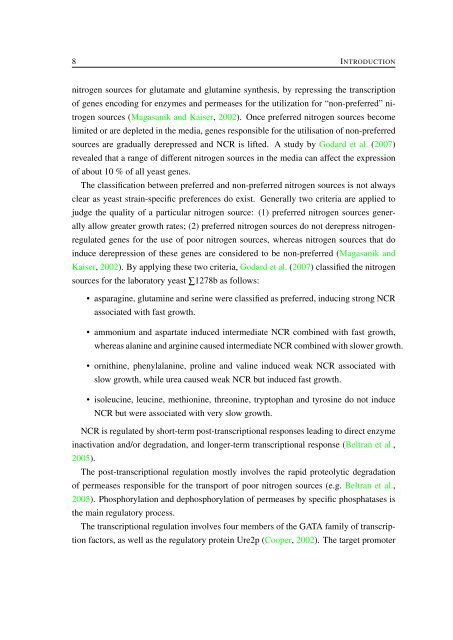Identification of yeast genes involved in Sauvignon Blanc aroma ...
Identification of yeast genes involved in Sauvignon Blanc aroma ...
Identification of yeast genes involved in Sauvignon Blanc aroma ...
You also want an ePaper? Increase the reach of your titles
YUMPU automatically turns print PDFs into web optimized ePapers that Google loves.
8 INTRODUCTIONnitrogen sources for glutamate and glutam<strong>in</strong>e synthesis, by repress<strong>in</strong>g the transcription<strong>of</strong> <strong>genes</strong> encod<strong>in</strong>g for enzymes and permeases for the utilization for “non-preferred” nitrogensources (Magasanik and Kaiser, 2002). Once preferred nitrogen sources becomelimited or are depleted <strong>in</strong> the media, <strong>genes</strong> responsible for the utilisation <strong>of</strong> non-preferredsources are gradually derepressed and NCR is lifted. A study by Godard et al. (2007)revealed that a range <strong>of</strong> different nitrogen sources <strong>in</strong> the media can affect the expression<strong>of</strong> about 10 % <strong>of</strong> all <strong>yeast</strong> <strong>genes</strong>.The classification between preferred and non-preferred nitrogen sources is not alwaysclear as <strong>yeast</strong> stra<strong>in</strong>-specific preferences do exist. Generally two criteria are applied tojudge the quality <strong>of</strong> a particular nitrogen source: (1) preferred nitrogen sources generallyallow greater growth rates; (2) preferred nitrogen sources do not derepress nitrogenregulated<strong>genes</strong> for the use <strong>of</strong> poor nitrogen sources, whereas nitrogen sources that do<strong>in</strong>duce derepression <strong>of</strong> these <strong>genes</strong> are considered to be non-preferred (Magasanik andKaiser, 2002). By apply<strong>in</strong>g these two criteria, Godard et al. (2007) classified the nitrogensources for the laboratory <strong>yeast</strong> ∑1278b as follows:• asparag<strong>in</strong>e, glutam<strong>in</strong>e and ser<strong>in</strong>e were classified as preferred, <strong>in</strong>duc<strong>in</strong>g strong NCRassociated with fast growth.• ammonium and aspartate <strong>in</strong>duced <strong>in</strong>termediate NCR comb<strong>in</strong>ed with fast growth,whereas alan<strong>in</strong>e and arg<strong>in</strong><strong>in</strong>e caused <strong>in</strong>termediate NCR comb<strong>in</strong>ed with slower growth.• ornith<strong>in</strong>e, phenylalan<strong>in</strong>e, prol<strong>in</strong>e and val<strong>in</strong>e <strong>in</strong>duced weak NCR associated withslow growth, while urea caused weak NCR but <strong>in</strong>duced fast growth.• isoleuc<strong>in</strong>e, leuc<strong>in</strong>e, methion<strong>in</strong>e, threon<strong>in</strong>e, tryptophan and tyros<strong>in</strong>e do not <strong>in</strong>duceNCR but were associated with very slow growth.NCR is regulated by short-term post-transcriptional responses lead<strong>in</strong>g to direct enzyme<strong>in</strong>activation and/or degradation, and longer-term transcriptional response (Beltran et al.,2005).The post-transcriptional regulation mostly <strong>in</strong>volves the rapid proteolytic degradation<strong>of</strong> permeases responsible for the transport <strong>of</strong> poor nitrogen sources (e.g. Beltran et al.,2005). Phosphorylation and dephosphorylation <strong>of</strong> permeases by specific phosphatases isthe ma<strong>in</strong> regulatory process.The transcriptional regulation <strong>in</strong>volves four members <strong>of</strong> the GATA family <strong>of</strong> transcriptionfactors, as well as the regulatory prote<strong>in</strong> Ure2p (Cooper, 2002). The target promoter














